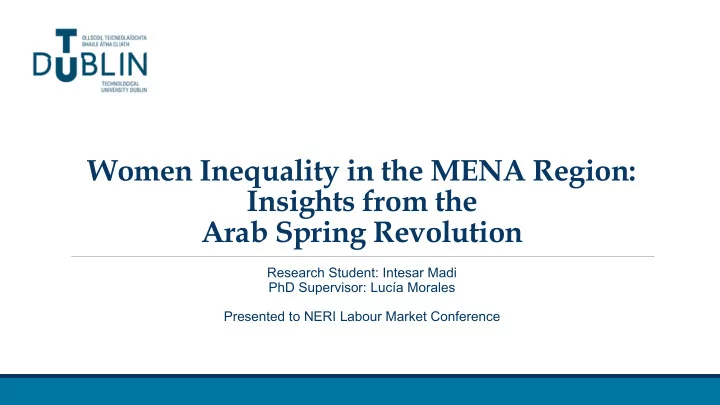

Women Inequality in the MENA Region: Insights from the Arab Spring Revolution Research Student: Intesar Madi PhD Supervisor: Lucía Morales Presented to NERI Labour Market Conference
Presentation outline Introduction Problem statement Research motivation Brief Literature Review Gender equality: why it matters Gender inequality in the MENA region Gender inequality and the Arab Spring Summary
Problem statement Gender inequality is still a huge issue today, despite widespread recognition of women’s rights and the benefits that accrue to all of society from equitable treatment and access to resources and opportunities for women and men, significant inequalities still persist, and a lot of work remains to be done.
Research Motivation This research study focus on women’s role in the economic and social context and implications in terms of economic development. To accomplish this objective, the research study examines the following issue: The role played by the Arab Spring revolution in highlighting inequality levels in the MENA region .
Brief Literature Review Most studies (for instance Rauch and Kostyshak, 2009; Moghadam, 2004; Ross, 2008; World Bank, 2012) used labour force participation to draw inference on the extent of gender inequality in the MENA and Muslim countries in general. However, gender inequality is a much broader concept involving labour market, economic and political empowerment, and reproductive health.
Author Year Paper title Research Methods Key findings Alawin & Sbitany 2019 Gender Inequality and Economic Panel data model. data set curvilinear relationship between Development in the MENA region. covering 17 countries over the economic development and two period (1991–2015) indicators of gender inequality; Female Labour Force Participation and Female Unemployment Rate. Stephan Klasen 2018 Poverty, Inequality, and the “Arab Rising inequality was not a driver Spring” of the Arab Spring. It appears more related to the declining fortunes of the middle classes, increasing dissatisfaction with the economic and political situation. Dandan & Marques 2017 Education, Employment and Gender Panel data regression analysis Negative relationship between Gap in Mena Region educational attainment and male labour participation rate, while it is positive in case of females labour force.
Nezahat Kucuk 2016 Gender Inequality in the Cross-sectional The impact of gender inequality MENA Region estimation, for 209 differs for the MENA. The paper countries obtains empirical evidence against the belief that the religion and oil are culprits responsible for holding women back in the MENA, Arab, and Muslim majority countries Jayachandran 2014 The roots of gender The findings of the paper pointed inequality in developing out that being a poor country is an countries. insufficient reason to explain gender inequality gaps and the increased favouritism of parents towards males rather than females. 2013 Buvinic et. Al. Violent Conflict and Gender difference-in-differences The impacts of conflict are Inequality heterogeneous and can either increase or decrease pre-existing gender inequalities. conflicts can provide opportunities for women in work and politics triggered by the absence of men.
Gender equality: why it matters? Women can make a significant contribution to the region’s economic model (IMF, 2017). Positive macroeconomic impact of increasing the labour market activity of women. Gender discrimination leads to decreased access of women to markets and educational and health services, then, in turn, it reduces the well-being of the children and the country‘s economic growth
Global Gender Gap Index by region over time.
Sources: World Economic Forum, Global Gender Gap index.2020
i SOURCES WORLD ECONOMIC FORUM, GLOBAL GENDER GAP INDEX.2020.
Gender gap by region, 2020 Middle East and North Africa 61.20% South Asia 66.10% Sub-Saharan Africa 68.00% East Asia and the Paciflc 68.50% Eastern Europe and Central Asia 71.50% Latin America and the Caribbeen 72.10% North America 72.90% Western Europe 76.70% Sources World Economic Forum, Global Gender Gap index.2020
Sources: World Economic Forum, Global Gender Gap index.2020
The Global Gender Gap Index rankings by region, 2020 Sources: World Economic Forum, Global Gender Gap index.2020
Gender inequality in the MENA Region The Middle East and North Africa (MENA) region has the lowest score (61.1%) of all regions in the Global Gender Gap Index. The gap has narrowed by 0.5 percentage points in 2019 and by 3.6 points since 2006. It is projected that, at the current rate of progress, it will take 140 years to close the gender pay gap in the region. Many women in the region continue to face limitations of basic rights, including for divorce, inheritance, asset ownership, access to justice and freedom of movement.
Gender inequality and the Arab Spring The Arab Spring revolution have played a role in highlighting income inequality levels in the MENA region, and unveiling social discontent that have pointed out to the need of reforms that address inequality issues and that seek to support women economic and social integration.
Summary Global attention remains focused on promoting human rights and eliminating discrimination and inequitable outcomes for women. Research on gender equality for the MENA region became more popular in the aftermath of the Arab Spring. Due to the fact that women do not have the same rights as men in this region. Identifying and analysing the factors that are driving economic inequality in the Arab countries is a critical issue.
Recommend
More recommend